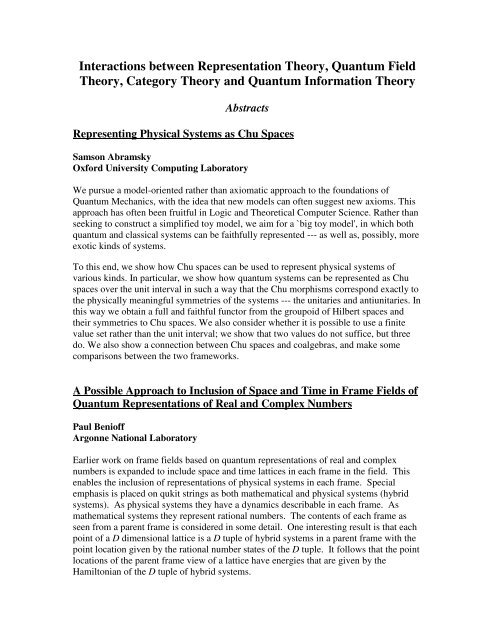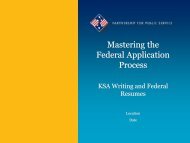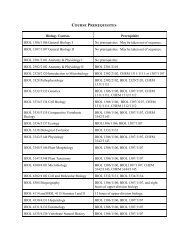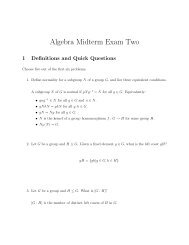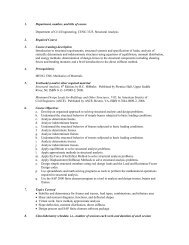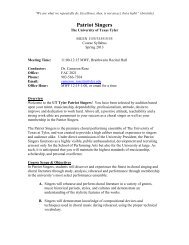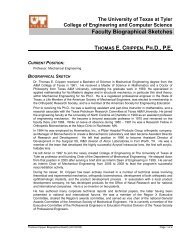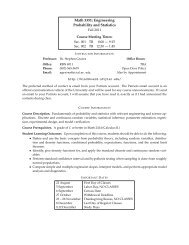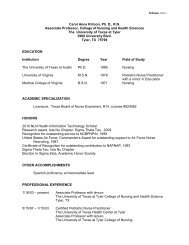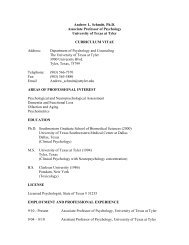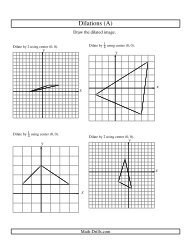Interactions between Representation Theory, Quantum Field Theory ...
Interactions between Representation Theory, Quantum Field Theory ...
Interactions between Representation Theory, Quantum Field Theory ...
- No tags were found...
Create successful ePaper yourself
Turn your PDF publications into a flip-book with our unique Google optimized e-Paper software.
<strong>Interactions</strong> <strong>between</strong> <strong>Representation</strong> <strong>Theory</strong>, <strong>Quantum</strong> <strong>Field</strong><br />
<strong>Theory</strong>, Category <strong>Theory</strong> and <strong>Quantum</strong> Information <strong>Theory</strong><br />
Abstracts<br />
Representing Physical Systems as Chu Spaces<br />
Samson Abramsky<br />
Oxford University Computing Laboratory<br />
We pursue a model-oriented rather than axiomatic approach to the foundations of<br />
<strong>Quantum</strong> Mechanics, with the idea that new models can often suggest new axioms. This<br />
approach has often been fruitful in Logic and Theoretical Computer Science. Rather than<br />
seeking to construct a simplified toy model, we aim for a `big toy model', in which both<br />
quantum and classical systems can be faithfully represented --- as well as, possibly, more<br />
exotic kinds of systems.<br />
To this end, we show how Chu spaces can be used to represent physical systems of<br />
various kinds. In particular, we show how quantum systems can be represented as Chu<br />
spaces over the unit interval in such a way that the Chu morphisms correspond exactly to<br />
the physically meaningful symmetries of the systems --- the unitaries and antiunitaries. In<br />
this way we obtain a full and faithful functor from the groupoid of Hilbert spaces and<br />
their symmetries to Chu spaces. We also consider whether it is possible to use a finite<br />
value set rather than the unit interval; we show that two values do not suffice, but three<br />
do. We also show a connection <strong>between</strong> Chu spaces and coalgebras, and make some<br />
comparisons <strong>between</strong> the two frameworks.<br />
A Possible Approach to Inclusion of Space and Time in Frame <strong>Field</strong>s of<br />
<strong>Quantum</strong> <strong>Representation</strong>s of Real and Complex Numbers<br />
Paul Benioff<br />
Argonne National Laboratory<br />
Earlier work on frame fields based on quantum representations of real and complex<br />
numbers is expanded to include space and time lattices in each frame in the field. This<br />
enables the inclusion of representations of physical systems in each frame. Special<br />
emphasis is placed on qukit strings as both mathematical and physical systems (hybrid<br />
systems). As physical systems they have a dynamics describable in each frame. As<br />
mathematical systems they represent rational numbers. The contents of each frame as<br />
seen from a parent frame is considered in some detail. One interesting result is that each<br />
point of a D dimensional lattice is a D tuple of hybrid systems in a parent frame with the<br />
point location given by the rational number states of the D tuple. It follows that the point<br />
locations of the parent frame view of a lattice have energies that are given by the<br />
Hamiltonian of the D tuple of hybrid systems.
Adaptive Coherence Conditioning<br />
Robert J. Bonneau<br />
Air Force Office of Scientific Research<br />
Many applications in sensing and pattern recognition involve situations where the size of<br />
the vector space required to detect and identify a target is unknown a-priori. Examples of<br />
this situation occur in sensing applications where the noise subspace is unknown or in<br />
pattern recognition where the sample support of the space is not known to distinguish one<br />
object from another. We propose a method whereby the measurement vector space can<br />
be adaptively resized depending the on the Bayesian risk of the estimators involved.<br />
We will first develop a Lagrange minimization strategy which parallels some recent<br />
Lasso techniques of trading coherence for Bayesian risk in selecting the size of the vector<br />
space necessary for a given detection problem. We then develop the adaptive coherence<br />
updating strategy based on a Newton gradient approach to assess the Bayesian risk at<br />
each stage of a detection problem and then update the coherence based on the steepest<br />
gradient decent until the permitted risk level is met. We will then show risk bounds for<br />
statistical distributions as a function of coherence, show the correspondence in<br />
performance to different statistical estimators, and show the impact of the technique in<br />
performance of detecting targets in simulated tomographic imagery.<br />
<strong>Quantum</strong> Computational Curvature and Jacobi <strong>Field</strong>s<br />
Howard E. Brandt<br />
U.S. Army Research Laboratory<br />
Recent developments in the differential geometry of quantum computation are exposited.<br />
In the Riemannian geometry of quantum computation [1]-[4], the quantum evolution is<br />
described in terms of the special unitary group of n-qubit unitary operators with unit<br />
determinant. The group manifold is taken to be Riemannian. To elaborate on several<br />
aspects of the methodology, the Riemannian curvature, Jacobi equation, and lifted Jacobi<br />
equation on the group manifold are reviewed. Conjugate points and the so-called<br />
geodesic derivative are also addressed. This is important for investigations of the global<br />
characteristics of geodesic paths in the group manifold, and the determination of optimal<br />
quantum circuits for carrying out a quantum computation. Several significant issues of<br />
the methodology are emphasized.<br />
[1] M. R. Dowling and M. A. Nielsen, “The Geometry of <strong>Quantum</strong> Computation,”<br />
<strong>Quantum</strong> Information and Computation 8, 0861-0899 (2008).<br />
[2] H. E. Brandt, “Riemannian Geometry of <strong>Quantum</strong> Computation,” to appear in<br />
Nonlinear Analysis (2008).<br />
[3] H. E. Brandt, “Riemannian Curvature in the Differential Geometry of <strong>Quantum</strong><br />
Computation,” to appear in Physica E (2009).<br />
[4] H. E. Brandt, “Riemannian Geometry of <strong>Quantum</strong> Computation,” AMS Short Course<br />
Lecture, to appear in Proc. Symposia in Applied Mathematics., American Mathematical<br />
Society (2009).
Perturbative expansions based on the Schrieffer-Wolff transformation<br />
Sergey Bravyi<br />
IBM<br />
It is widely believed that perturbative series for quantum field theory and many-body<br />
physics do not converge but are to be viewed as asymptotic series, meaning that their<br />
lowest-order terms provide a good approximation to the quantity of interest while<br />
inclusion of higher-order terms may actually give a worse result. We provide a<br />
quantitative version of this conjecture which can be rigorously proved for a large class of<br />
quantum spin models in which the unperturbed (free) Hamiltonian describes noninteracting<br />
spins (qudits) while the perturbation is a k-local Hamiltonian. Our proof relies<br />
on the Schrieffer-Wolff transformation of many-body physics which allows one to derive<br />
an effective low-energy Hamiltonian preserving locality features of the original<br />
Hamiltonian.<br />
This is a joint work with D. DiVincenzo (IBM) and D. Loss (U. Basel)<br />
A Unified Treatment for the Universality of <strong>Quantum</strong> Gates for Various<br />
<strong>Quantum</strong> Computing Gates<br />
Goong Chen<br />
Texas A&M University<br />
Universal quantum gates of one or two qubits can be designed from various quantum<br />
computing devices such as cavity-QED, ion and atom traps, quantum dots, linear optics,<br />
SQUIDs, etc. The establishment of universality of such devices depends on their<br />
Hamiltonians, and the proofs vary accordingly because such Hamiltonians usually are not<br />
conjugate to each other. In this talk, we try to find Lie-algebraic approaches to establish a<br />
somehow unified connection <strong>between</strong> the different Hamiltonians in order to obtain the<br />
universality of two bit gates. We hope that, eventually, such a unified treatment could<br />
facilitate future quantum circuit design where several devices need to be used in a circuit.<br />
This work is a collaboration with V. Ramakrishna.<br />
Depicting non-locality<br />
Bob Coecke<br />
Oxford University Computing Laboratory<br />
The punch-line of this talk is to "depict non-locality", that is, to provide a pictorial<br />
presentation of the flow of information which, due to Bell/GHZ-type arguments, cannot<br />
be given a stochastic spatio-temporal causal explanation. We will show that in the case<br />
of qubits the performed computation is that of an AND-gate on the choices of<br />
measurements made by distant observers. This work points at a research project that
classifies the computations which nature performs "outside of space-time". It builds<br />
further on results on so-called "phase-groups of observables" in:<br />
[1] with Ross Duncan: "Interacting quantum observables". ICALP'08. arXiv:0906.4725<br />
[2] with Bill Edwards and Rob Spekkens: "The group-theoretic origin of quantum nonlocality".<br />
http://web.comlab.ox.ac.uk/publications/publication3026-abstract.html<br />
Within an abstract category-theoretic setting we in particular reproduce<br />
the result of:<br />
[3] Janet Anders and Dan Browne: "Computational power of correlations" Phys Rev Lett<br />
102, 050502 (2009). arXiv:0805.1002<br />
where it was shown that GHZ-correlations enable to boost parity computations into<br />
universal classical computation. Informal introductions to the abstract categorytheoretic/diagrammatic<br />
framework that constitutes the backbone of our developments are:<br />
[4] "Kindergarten quantum mechanics". arXiv:quant-ph/0510032<br />
[5] "Introducing categories to the practicing physicist". arXiv:0808.1032<br />
Recent extensive tutorial introductions are:<br />
[6] "<strong>Quantum</strong> picturalism". Contemporary Physics '09. arXiv:0908.1787<br />
[7] "Categories for the practicing physicist". arXiv:0905.3010<br />
Free Knots: Parity and Cobordisms<br />
Denis P. Ilyutko, Vassily O. Manturov<br />
Moscow State University<br />
Both classical and virtual knots arise as formal Gauss diagrams modulo some abstract<br />
moves corresponding to Reidemeister moves. If we forget about both over/under<br />
crossings structure and writhe numbers, we get simplification of virtual knots and links:<br />
free knots and free links. Free knots and links are also called homotopy classes of Gauss<br />
words and phrases. Obviously, all the free knots corresponding to classical knots are<br />
unknot. However, many virtual knots survive after this simplification. We construct<br />
invariants of free knots and present their applications to minimality problems of virtual<br />
knots. We also investigate cobordisms of free knots. We define a new strong invariant of<br />
free knots which allows to detect free knots not cobordant to the trivial one.
Topological <strong>Quantum</strong> Information <strong>Theory</strong><br />
Louis Kauffman<br />
University of Illinois, Chicago<br />
This talk will discuss topological models for quantum computation and will concentrate<br />
on the Fibonacci model, basing it on their coupling theory associated with the Jones<br />
polynomial. We will discuss quantum algorithms for computing the Jones polynomial<br />
based on their coupling formalism and also the AJL algorithm of Aharonov, Jones and<br />
Landau that is based directly on representations of the Temperley-Lieb algebra. It is<br />
intended that this talk be self-contained both for quantum information and for topology.<br />
Spectrum of the density matrix<br />
Vladimir Korepin<br />
Stony Brook University<br />
I consider the ground state of a spin chain. The density matrix of a large block of spins is<br />
interesting for its description of entanglement. I show that the spectrum is essentially<br />
different for the Heisenberg model and for AKLT. In two dimensions, the spectrum is<br />
used to calculate topological entanglement.<br />
An Intuitive Overview of the <strong>Theory</strong> of <strong>Quantum</strong> Knots<br />
Samuel Lomonaco<br />
University of Maryland Baltimore County<br />
Coauthor: Louis Kauffman<br />
We present the theory of quantum knots from an intuitive perspective. A quantum knot<br />
system is a physically implementable quantum system whose states, called quantum<br />
knots, represent the spatial configuration of a closed knotted piece of rope in 3-space. The<br />
dynamic behavior of this quantum system according to Schroedinger's equation<br />
represents the movement of a closed knotted piece of rope smoothly moving through 3-<br />
space in such a way as to not pass through itself. We give two equivalent definitions, one<br />
based on mosaic knots, the other on lattice knots. The talk ends with a list of open<br />
questions.
Adventures in Entanglement<br />
John M. Myers<br />
Harvard University<br />
Quantification of entanglement for mixed 2-qubit states can make use of Wootters'<br />
concurrence, but more complex states, pure or mixed, continue to present a puzzle.<br />
Motivated by an interest in quantum sensing, we define a degree of entanglement,<br />
starting with bipartite pure states and building up to a definition applicable to any mixed<br />
state on any tensor product of finite-dimensional vector spaces. For mixed states the<br />
degree of entanglement is defined in terms of a minimum over all possible<br />
decompositions of the mixed state into pure states. Using a variational analysis we show<br />
a property of minimizing decompositions. Combined with data about the given mixed<br />
state, this property determines the degrees of entanglement of a given mixed state. For<br />
pure or mixed states symmetric under permutation of particles, we show that no partial<br />
trace can increase the degree of entanglement. For selected less-than-maximallyentangled<br />
pure states, we quantify the degree of entanglement surviving a partial trace.<br />
Invariants of Knots and Links Arising from Finite-Dimensional<br />
Algebras<br />
David Radford<br />
University of Illinois at Chicago<br />
Finite-dimensional algebras of a certain type over a field k possess structures from which<br />
regular isotopy invariants of knots and links can be constructed. We develop a general<br />
theory for these algebras, develop a general theory for a class of finite-dimensional<br />
algebras over k from which regular isotopy invariants of oriented knots and links can be<br />
constructed, and we consider relationships <strong>between</strong> algebras in the two classes.<br />
A very important problem which has proven rather daunting is computation of these<br />
invariants. Just how rich the collection of invariants described in the preceding paragraph<br />
is remains a mystery, a longstanding unsolved problem.<br />
Probably the most intriguing invariant is the one originating in the work of Hennings<br />
which arises from the Drinfel'd double D(H) of certain finite-dimensional Hopf algebras<br />
H over k. How this invariant is related to the Kuperberg's invariant of 3-manifolds<br />
derived from H is partially understood. Computing the invariant arising from D(H)could<br />
be very illuminating and useful.<br />
The ideas we discuss are for the most part based on the joint work of the author and Louis<br />
Kauffman.
Classifying Modular Categories<br />
Eric Rowell<br />
Texas A&M University<br />
I will discuss recent developments in the classification of low rank modular categories.<br />
In particular, I will discuss joint work with Zhenghan Wang and Richard Stong<br />
classifying unitary modular categories of rank


